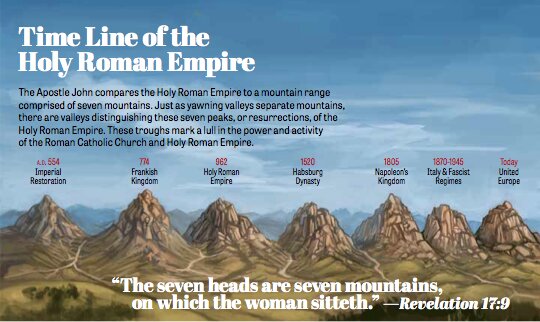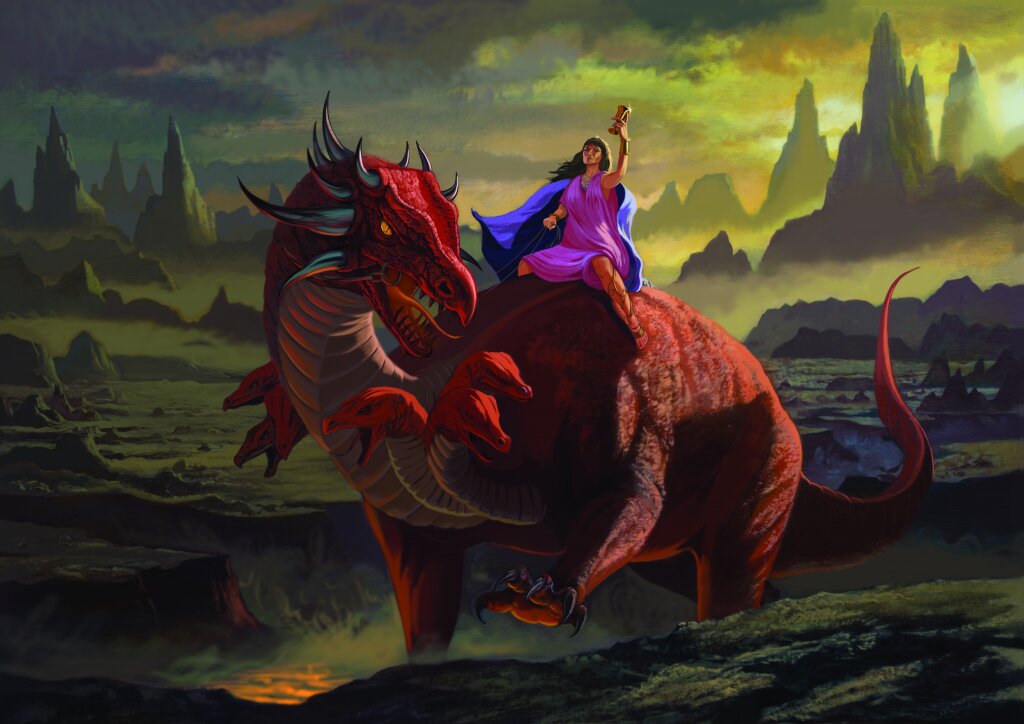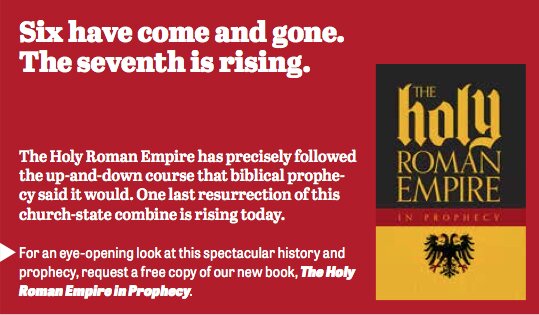Watch Europe for a Revival of the Holy Roman Empire
Europe is a mess. Recent headlines have been dominated by economic brinksmanship, impassioned public protests, all-night wrangles among leaders trying to prevent Greece from going bankrupt, leaving the eurozone and hurling the entire European Union into the abyss.
Amid the uncertainty, one reality seems certain, at least to most observers: The European Union is dying—slowly, painfully and publicly. The hope of European countries forming a united, stable, democratic, geopolitically consequential entity is vanishing. The future of global politics and power, many believe, belongs to the likes of China, Russia, Iran and the United States. The EU, assuming it can survive the current crisis, is destined to remain, at best, a secondary power.
The Trumpet forecasts a different future.
Europe will unite and it will become a formidable global dynamo. The unity Europe attains will not be perfect, it will not come about easily or peacefully, and it certainly will not endure. But Europe will unite to become a serious, daunting global power. The emergence of this new Europe will have far-reaching and dramatic consequences for us all.
This forecast is underpinned by two basic proofs. First, like the goal of European unity itself, it is supported by more than 1,500 years of European history. Second, it is supported by Bible prophecy.
Founded in 1951, initially as the European Coal and Steel Community, the European Union was created with the fundamental goal of reviving the ancient Holy Roman Empire. This might be hard to envision, considering what a debacle the EU is today. Nevertheless, the cherished and publicly stated goal of some Europeans, especially European leaders, is to resurrect the Holy Roman Empire.
What was the Holy Roman Empire? What would a resurrected Holy Roman Empire look like?
This empire—its composition and character, its behavior and accomplishments—was prophesied, repeatedly and in vivid detail, in the Bible. Where are these prophecies? Have they been fulfilled? What do they mean for the future of Europe, and for mankind?
Some of the answers are not pleasant, but we need to know.
Reviving the Holy Roman Empire
Brendan Simms is a historian and a professor of history at Cambridge University. In 2013, he wrote an article in the New York Times titled “The Ghosts of Europe’s Past.” “The cheerleaders of the European Union like to think of it as an entirely new phenomenon, born of the horrors of two world wars,” he wrote. “But in fact it closely resembles a formation that many Europeans thought they had long since left to the dustbin of history: the Holy Roman Empire …” (June 9, 2013).
Not all Europeans, however, confined the Holy Roman Empire to the dustbin of history. Here is how Otto von Habsburg, a descendant of that famous line of European royalty, put it in 1989: “The [European] Community is living largely by the heritage of the Holy Roman Empire, though the great majority of the people who live by it don’t know by what heritage they live.”
These are important words from an important man. Together with other leading figures such as Konrad Adenauer, Robert Schuman and Jean Monnet, this man built the European Community, which today we call the European Union. Habsburg died in 2011. He was a descendant of the Habsburg line of European royalty and former crown prince of the Austro-Hungarian Empire. He was one of the leading architects of modern Europe—and his statement discloses the vision that underpins modern Europe.
To appreciate the significance of this truth, we need to understand the history and nature of the Holy Roman Empire—particularly the identity of the “holy” in its name.
Among historians, it is generally accepted that the Holy Roman Empire was the cyclical reincarnation of the ancient Roman Empire, presided over in each instance by the Catholic Church. Oxford Dictionary defines it as the “empire set up in Western Europe following the coronation of Charlemagne as emperor in the year 800. It was created by the medieval papacy in an attempt to unite Christendom under one rule.”
These descriptions are accurate, but are woefully incomplete.
Mr. Habsburg lived in Vienna, Austria, the heart of the ancient Holy Roman Empire, and he often spoke about an illustrious crown on display in Vienna’s Hofburg Palace. “We do possess a European symbol which belongs to all nations equally,” he once said. “This is the crown of the Holy Roman Empire, which embodies the tradition of Charlemagne.”
The founders of the EU, and many European leaders today, readily acknowledge that the supreme goal of the European Union is to live “by the heritage of the Holy Roman Empire.” European politicians regularly declare their admiration for Charlemagne and publicly admit that they seek to create a united Europe that “embodies the tradition of Charlemagne.”
What is the “heritage of the Holy Roman Empire”? Who was Charlemagne? What is the “tradition of Charlemagne”? We need the answers to these questions if we are to understand modern Europe and anticipate its future.
Modern Europe wants to resurrect the Holy Roman Empire. That means this history is also prophecy of the imminent future. Examining the history that is informing the modern revival of this church-state combine provides a glimpse into the immediate future of both Europe and the world. That makes this a subject of paramount importance.
Proving God and His Word
Adding another dimension of importance to this subject is what the Bible says about the Holy Roman Empire. Any attempt to discuss it without employing Scripture is doing this subject injustice. In fact, the history of the Catholic Church and the Holy Roman Empire proves the veracity of God’s infallible Word.
Note some statements in Scripture that begin to show this truth.
In Isaiah 46:9-10, He says, “… I am God, and there is none like me, Declaring the end from the beginning, and from ancient times the things that are not yet done, saying, My counsel shall stand ….”
In Isaiah 40, He says, “To whom then will ye liken me, or shall I be equal? saith the Holy One. Lift up your eyes on high, and behold who hath created these things …. Behold, the nations are as a drop of a bucket, and are counted as the small dust of the balance …. All nations before him are as nothing …” (verses 25-26, 15, 17).
The God of the Bible is the ultimate authority in the affairs of mankind. Few realize it today, but God sanctions the rise and fall of human empires and nations. He decides the borders of nations. He oversees all major developments in international relations. God reigns supreme in the affairs of men.
Another important truth that might surprise the reader is this: The Bible clearly shows that this is not God’s world. This world’s customs and traditions, cultures and societies, lifestyles, governments and economies of human civilization were not designed by God, and He does not endorse them. The Bible teaches that this world is under the control and influence of Satan the devil, a former archangel who rebelled against God (e.g. 2 Corinthians 4:4; Ephesians 2:2; Revelation 12:9). This explains the presence of so much evil and unhappiness in our world.
But the profound influence of the devil on this world does not preclude God’s involvement in world events.
Psalm 33:10-15 say, “The Eternal wrecks the purposes of pagans, he brings to nothing what the nations plan; but the Eternal’s purpose stands for ever, and what he plans will last from age to age. … The Eternal looks from heaven, beholding all mankind; from where he sits, he scans all who inhabit the world; he who alone made their minds, he notes all they do” (Moffatt translation).
Any person who has the humility to meditate on that scripture will see that it is astonishingly hopeful and inspiring.
The tendency of human nature is to focus on the self, to behave as if the universe revolves around oneself. Thus blinded by vanity and self-absorption, individually and collectively, most people fail to see and accept that God is the ultimate authority in the affairs of humanity.
This is why God gives Bible prophecy: to prove that He exists and that He reigns supreme.
Though this world and human nature are under the influence of the devil, God steers world events to ensure that every word He has uttered is fulfilled exactly as He said. God monitors everything, and He sanctions every major and even many minor decisions and developments.

This is one of the most hopeful, assuring truths a person can know. And the history of the Catholic religion and the Holy Roman Empire provide quantifiable, living, irrefutable proof of this truth.
How?
How Relevant Is Prophecy?
In this world—even in much of traditional Christianity—Bible prophecy is almost universally ignored and rejected. But did you realize that fully one third of the Bible is devoted to prophecy? To discard prophecy is to discard one third of the Bible.
The great majority of Bible prophecy revolves around the time we are currently living in and the months and years ahead. Author and educator Herbert W. Armstrong taught that 90 percent of the Bible’s prophecy is for our time. This is an astounding truth when you consider that the final canon of the Bible was finished more than 1,900 years ago.
Moses wrote the first five books of the Bible, which comprise the Pentateuch, roughly 1,400 years before the lifetime of Jesus Christ. The major and minor prophets, which are filled with so much prophecy, were written between 400 and 800 years before Christ. The Apostle John wrote his gospel, his epistles and the book of Revelation in the final decade of the first century, and authorship of the Bible was completed by a.d. 100.
Now think on this.
If the Holy Roman Empire was discussed in the Bible long before it even existed—in some instances, more than a thousand years prior to it coming on the scene—then this would surely prove the existence of a higher power, a divine architect, a supreme being capable of intervening in human affairs and shaping world history.
If the Holy Roman Empire is indeed fulfilled prophecy, then it is dramatic, tangible, undeniable proof of God’s existence. And if the prophecy of the Holy Roman Empire is accurate, then other biblical prophecies and truths would surely also be accurate. This would make the Bible a valuable resource for forecasting world events—even for preparing for them.
So, was the Holy Roman Empire prophesied in the Bible?
Holy Roman Empire Prophesied
The Holy Roman Empire is spoken of in multiple prophecies in both the Old and New Testaments. Let’s look at one specific chapter—written more than 400 years before the Holy Roman Empire came into existence—that gives a detailed, thorough explanation of this empire’s nature and motives, its leadership, and its accomplishments.
The book of Revelation is about “things which shall be hereafter,” or events that would occur after John’s time (Revelation 1:19). Revelation contains prophecy of end-time events. Revelation 17 was written by the Apostle John around a.d. 90. The specific purpose of this pivotal chapter, as verse 1 plainly states, is to describe the “judgment of the great whore that sitteth upon many waters.” This “great whore” symbolizes a specific institution. In this chapter, God gives John a vision, beginning in verse 3, in which He gives the apostle insight into the character and conduct of this institution, and a look at its final judgment and its end.
John’s vision contains three primary characters. The first two are revealed in verse 3: “So he carried me away in the spirit into the wilderness: and I saw a woman sit upon a scarlet coloured beast, full of names of blasphemy, having seven heads and ten horns.” The third is revealed in verse 6: “And I saw the woman drunken with the blood of the saints, and with the blood of the martyrs of Jesus: and when I saw her, I wondered with great admiration.”
The first character of Revelation 17 is the “whore” or “woman,” which in biblical language represents a religion, or church (e.g. Ephesians 5; 2 Corinthians 11:2). The second is the beast that has seven heads and 10 horns. The third is the “saints” or “martyrs,” a group of people the “woman” lives to persecute and destroy.
Revelation 17:4 says this “woman” is “arrayed in purple and scarlet colour, and decked with gold and precious stones and pearls ….” She is conspicuously wealthy, overflowing with material splendor. She is a famous religion known and revered by people across the planet (see also verses 2 and 15 and Revelation 18:3).
The scene in Revelation 17:3 of the woman riding, or guiding, the beast depicts a religion brandishing political power. Verse 2 says the “kings of the earth have committed fornication” with her. Verse 18 says, “And the woman which thou sawest is that great city, which reigneth over the kings of the earth.” This religion enmeshes itself with the affairs of kings and empires. It is a power player in international relations.

Revelation 17 is clear. This religion is incredibly wealthy; it has a global presence and influence; it is a potent force in politics and international relations; and it uses the beast to pursue its grim ambitions.
Now look at the beast it rides. Verse 3 says this creature has seven heads and 10 horns. Verse 9 says that the “seven heads are seven mountains, on which the woman sitteth.” In biblical language, a mountain is a symbol for a nation or kingdom (e.g. Isaiah 2:2-3). Here, each “head” signifies a distinct kingdom, or empire.
Revelation 17:10 reveals that these seven heads are also “seven kings,” or seven individuals, each ruling a kingdom. The seven heads represent seven distinct empires, or kingdoms, each with its own king. Verse 10 shows that these empires, or kingdoms, are successive, not concurrent.
All of these kings, or kingdoms, are inspired and led by the woman. To Catholics, the Holy Roman Empire is secular history, with the Vatican trapped in the middle as a reluctant and unwilling participant. That is not true.
Finally, what do the 10 horns represent? Again, Scripture reveals the answer. Verses 12-14 show that the 10 horns represent 10 kings, or 10 nations, that coalesce around and submit themselves to the superior king ruling over the seventh kingdom.
Now let’s summarize the prophetic message of Revelation 17. This vision is obviously about a towering church—a wealthy, imperialistic, ambitious religion—presiding over the rise of seven distinct empires, or kingdoms, each ruled by a specific king. And this woman uses her influence over each empire to try and destroy the true “saints” of God.
Study history and you will come to appreciate how perfect this description of the Holy Roman Empire is. The Holy Roman Empire that is recorded and discussed in countless history books. The Holy Roman Empire whose history is still plainly evident in the cathedrals and castles, the ruins and battlefields, the symbols and memorabilia, the customs and practices of Europe today.
Most significantly, you will see what an apt description it is of the Holy Roman Empire currently resurrecting in Europe.
And to think, Revelation 17 was written more than 400 years before the first manifestation in Europe of the Holy Roman Empire.
Fulfilled Prophecy
These are some harsh truths: that the Catholic religion is the “woman” of Revelation 17; that the Holy Roman Empire is the seven-headed beast ridden by the woman; and that together these two seek to undermine, persecute and destroy the true religion of God.
Bible prophecy says the final resurrection of the Holy Roman Empire will cause global devastation that will affect every person on Earth. The destruction and suffering will be exponentially worse than World War ii.
The history of the Holy Roman Empire proves God’s existence and the veracity of His Word. This is a truth that every person on Earth will have to come to understand and that every reader would do well to think seriously about. The message, if you really get it, is important, wonderful and life-changing.
Consider it. If God prophesied in the first century that a great false religion would preside over seven distinct empires, and subsequent history shows a great religion presiding over seven distinct empires, this is fulfilled prophecy.
If a prophecy is obviously fulfilled, that proves that a supreme power capable of bringing that prophecy to fruition also must exist. No man could forecast something like the Holy Roman Empire, and certainly no man could influence world conditions over the course of two millennia to bring it to pass. If the Holy Roman Empire exists, and if it looks and behaves exactly as God prophesied it would, then God must exist.
Now think about the consequences of proving God’s existence.
If God really does exist—if He is alive and living, all-powerful and supreme—then what is His purpose? What is man? What is man’s future?
If God exists, then mankind, despite the chaos and hopelessness that engulfs us, has a bright future. If God exists, and if what He teaches in the Bible is true, then there is reason to be optimistic. If God exists, then there is cause for hope.
Doesn’t the world right now—don’t you—need some hope?

